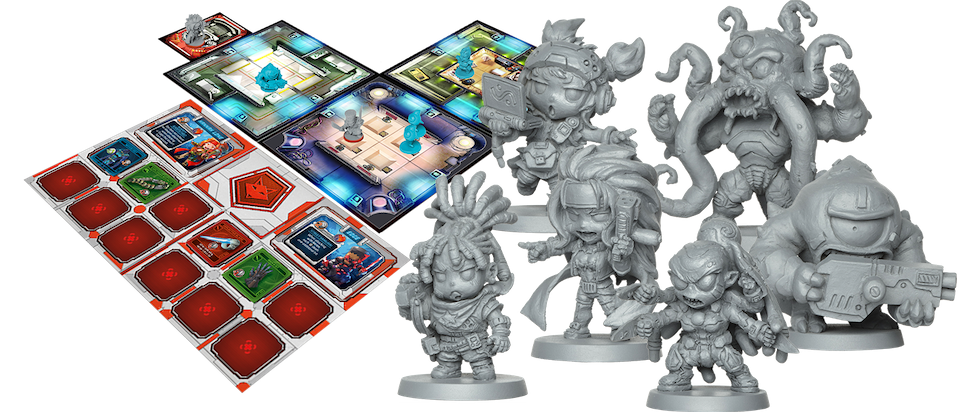
Space is the Place: Starcadia Quest and the Mystery of Aesthetics
I see board games in the store and they always look so cool and then I buy them and bring them home, I’m so excited to open them, and then I play them, like, twice… This column is dedicated to the love of games for those of us whose eyes may be bigger than our stomachs when it comes to playing, and the joy that we can all take from games, even if we don’t play them very often.
———
When you engage in the work of being a critic, part of your job is to be able to explain why you feel a certain way. Of course, sometimes we simply can’t. However hard we try, we can’t always trace down the root – or even the perceived root – of why something works for us, or doesn’t. In those cases, our job becomes to couch that feeling in a way that makes it clear that we don’t know where it comes from, and that it may very well come from a deeply biased place without much merit.
I can’t explain why the art in Starcadia Quest mostly works for me while the art in Arcadia Quest was a dealbreaker. The caricature-style art is pretty much exactly the same, and there’s no coherent reason why it should suddenly feel palatable in a sci-fi setting when I couldn’t abide it in a fantasy one. And yet, here we are.
For those who don’t remember, Arcadia Quest is a fantasy-themed guild battler from CMON that was the subject of our very first Versus Mode here at I Played It, Like, Twice. And it may be unsurprising to learn that Starcadia Quest is pretty much that exact same game but in spaaaaaaaaaace!
Instead of guilds, you’ll be building out the crews of spaceships but, as with Arcadia Quest, a standard game of this sci-fi iteration sees players taking control of a handful of heroes (the crew of said ship) and pitting them against the crews of other ships as well as the enemies that populate the board.
It’s a very different way to play this kind of game, and one that should appeal to those who want the more head-to-head style of gameplay from more traditional board games while still utilizing all the minis and board tiles and other various gewgaws associated with the dungeon crawler.
As I said in that earlier article, the art style of Arcadia Quest doesn’t work for me, but I like the basically identical art in Starcadia Quest much better, for no reason that makes any sense. Similarly, I can’t explain why I also like the idea of your teams being the crew of a spaceship more than I do them being the members of a fantasy guild. But, as I said, here we are.

Beyond differences of setting, Starcadia Quest plays a lot like its fantasy predecessor. Two or more teams of heroes go up against one another and the board in various pre-generated missions using the same kinds of large, square tiles divided into a 3×3 grid that will be familiar to anyone who has played other CMON games such as Zombicide or Massive Darkness.
In addition to the base game, Arcadia Quest has rolled out a wide array of expansions over the years, including ones adding pets and mounts. Starcadia Quest hasn’t produced quite as many, but has turned out its own take on a similar idea with the Build-A-Robot expansion, which adds a sci-fi innovation to the pets concept by allowing for cute, diminutive robots with swappable heads and bodies. It’s honestly maybe the most purely fun thing in the entire line, and the adorable little customizable robots are probably worth it on their own for hobbyists who like the visuals of this series.
Like most CMON products, Starcadia Quest was funded via Kickstarter, which unlocked a whole host of stretch goals and add-ons. As with Arcadia Quest, many of these are spoofs of popular sci-fi properties with the serial numbers only just barely filed off. There are characters here who will be familiar from such works as Star Wars, Star Trek, Aliens, Tron, Blade Runner, Firefly, RoboCop, Terminator, and even more unlikely places such as Marvel’s Blade or Davy Jones from Pirates of the Caribbean.
In particular, the Kickstarter included two Kickstarter-exclusive add-ons introducing new enemies and missions that specifically borrowed from Star Wars (“Thornetroopers”) and Aliens (“Zenith Invasion”). And, I’m not going to lie, the frankly adorable chibi xenomorphs from the “Zenith Invasion” box were big selling points for me.
As is usually the case in these kinds of situations, while Starcadia Quest and a few of its expansions are available at your friendly local game store, most others are Kickstarter exclusives, which is probably one of the only ways that you can get away with making a game using so many “borrowed” characters without getting slapped with half-a-dozen cease and desist letters from various IP holders.
Meaning that if you want to play Starcadia Quest with your friends, you can probably pick up a copy for less than a hundred dollars, at the time of this writing. But if you want those cute xenomorphs from the “Zenith Invasion” expansion, you’ll probably be paying a whole lot more to an aftermarket reseller. Such are the perils of these kinds of Kickstarter-funded games, a subject that I’ve touched upon before.
———
Orrin Grey is a writer, editor, game designer, and amateur film scholar who loves to write about monsters, movies, and monster movies. He’s the author of several spooky books, including How to See Ghosts & Other Figments. You can find him online at orringrey.com.





